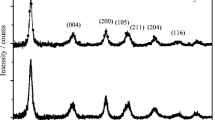Abstract
The electrical conductivity of resistive oxygen sensors based on semiconducting titanates (BaTiO3, SrTiO3) is determined by the amount and the ratio of the different concentrations of atomic defects in the sensor material. At sufficiently high temperatures the sensor exchanges oxygen with the surrounding gas atmosphere resulting in variations of the concentration of defects. The kinetics of these oxygen exchange processes are determined by the diffusion of the defects in the solid. In this paper the diffusion coefficients of the defects, which are decisive for the electrical conductivity, are determined by measurement of the conductivity during the diffusion processes. The evaluation of these results by an analytical model which considers the interaction between all simultaneously diffusing types of defects, allows a survey of the effects influencing the diffusion rate. With this knowledge, it is possible to estimate the influence of grain boundaries, acceptors, temperature and oxygen pressure on the response time of the sensor.
Similar content being viewed by others
References
J. Daniels, K.H. Härdtl: Philips Res. Rep.31, 489 (1976)
R. Wernicke: Philips Res. Rep.31, 526 (1976)
E.M. Logothetis: Ceram. Eng. Sci. Proc.1, 281 (1980)
E.M. Logothetis: Sensors and Actuators4, 330 (1983)
W. Weppner: Enhanced Motion in Solid Electrode Materials. In:Materials for Advanced Batteries, ed. by Murphy, Broodhead, Steele (Plenum, New York 1980)
C. Wagner: Z. Phys. Chem.32, 447 (1936)
D.B. Schwarz, H.U. Anderson: J. Electrochem. Soc.122, 707 (1975)
A.E. Paladino: J. Am. Ceram. Soc.48, 476 (1965)
L.C. Walters, R.E. Grace: J. Phys. Chem. Solids28, 245 (1967)
A. Müller: Thesis, Universität Karlsruhe, FRG, 1988
S.A. Long, R.N. Blumenthal: J. Am. Ceram. Soc.54, 515, 577 (1971)
U. Balachandran, N.G. Eror: J. Solid State Chem.39, 351 (1981)
N.G. Eror, U. Balachandran: J. Solid State Chem.42, 227 (1982)
N.-H. Chan, R.K. Sharma, D.M. Smyth: J. Electrochem. Soc.128, 1762 (1981)
N.-H. Chan, R.K. Sharma, D.M. Smyth: J. Am. Ceram. Soc.64, 556 (1981)
G.M. Choi, H.L. Tuller: J. Am. Ceram. Soc.71, 201 (1988)
R. Paul:Halbleiterphysik (Dr. A. Hüthig-Verlag, East Berlin 1956)
K. Lehovec, A. Slobodskoy: Solid State Electronics3, 45 (1961)
A.D. Kurtz, R. Yee: J. Appl. Phys.31, 303 (1960)
W. Weppner: Reprint fromTransport-Structure Relations in Fast Ion and Mixed Conductors, ed. by F.W. Poulsen, Riso National Laboratory, Roskilde 1985
L. Heyne, S. Geller (Eds.):Solid Electrolytes, Springer, Berlin, Heidelberg 1977)
W. van Roosbroek: Phys. Rev.91, 282 (1953)
W. van Roosbroek: Bell System Techn. J.29, 560 (1960)




